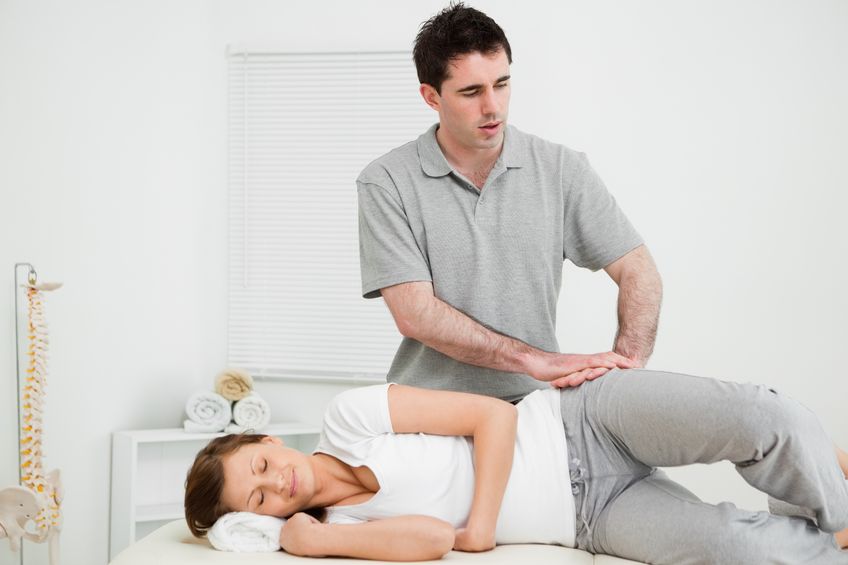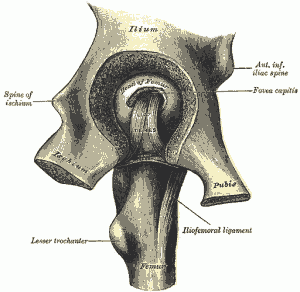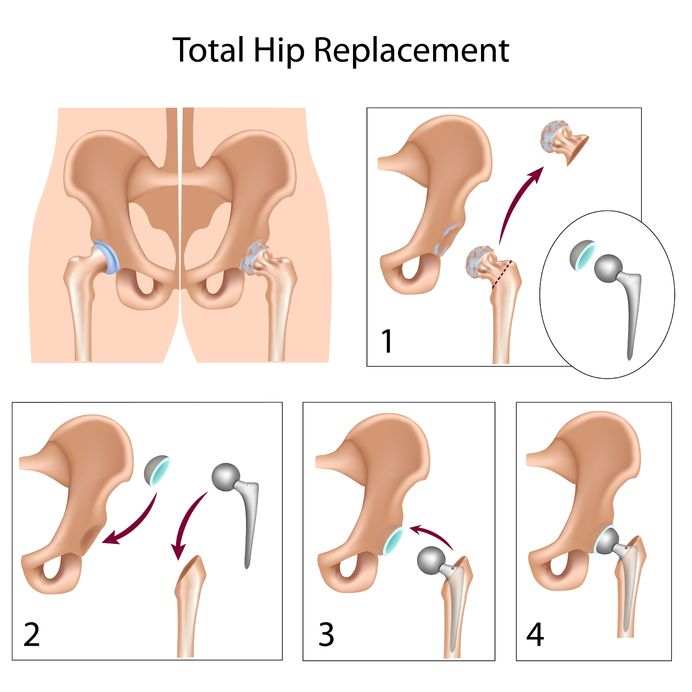Total Hip Replacement

Tips When Considering Hip Replacement
- Seek a medical evaluation by your Physical Therapist if you have hip/groin pain.
- Most arthritic changes in the hip are felt in the groin area, not the lateral aspect of the hip (by the pocket on your pants).
- Reduce the amount of high impact activities (running, jumping) in your 3rd decade and continue to cross train with less impact activities as you age.
- Don’t smoke.
- Maintain a good strengthening and stretching program for the hips that will enable the muscles to “do the work” and not the bones.
Total Hip Arthroplasty…What To Expect
Total Hip Replacement or Total Hip Arthroplasty (THA) is an extremely common orthopaedic surgical procedure that is performed to replace degenerative parts of the hip joint. The number of THA surgeries performed yearly in the United States ranges from 150,000 to almost double that number.* Regardless of the exact number, it is fair to say that degenerative hip joints are one of the most common conditions that Physical Therapists and other orthopaedic health care providers deal with on a daily basis.
Physical Therapy plays a vital role in all phases of hip replacement. Prior to THA, a Physical Therapist can develop an exercises regimen for patients that will speed recovery and in some cases delay the surgery. After surgery, Physical Therapists can help patients reduce pain, reduce the likelihood of potential problems and increase the probability for long-term successful recovery.
Understanding the Hip Joint
The human hip joint is one of the largest joints in the body. It consists of the Acetabulum, a cup like structure in the pelvis and the Head of the Femur, which is round like a ball. This is a “ball-n-socket” joint that enables the hip/leg to move in many directions or planes of motion. The Acetabulum and the Head of the Femur are lined or covered with Articular cartilage (Hyaline cartilage). This cartilage is a smooth thin covering that reduces friction and helps to absorb shock. There is a thin lining (Synovial membrane) between the two pieces of bone, and it provides a small amount of lubricating fluid. The depth of the Acetabulum provides a stable housing for the Head of Femur and the two bones are stabilized further with numerous “leather like” ligaments.

Damaged Hip Joint
The hip joint is subjected to a tremendous amount of force during everyday activities (both compressive and sheer force). Unfortunately, in some people the amount of force is greater than the bones and more specifically the Hyaline or Articular cartilage can withstand, leading to damage or a degenerative change. Common causes for degenerative change include the following:
- Arthritis such as Osteoarthritis (most common), Rheumatoid, and traumatic
- Lack of blood flow to the Femoral Head (avascular necrosis)
- Childhood diseases
The damaged cartilage cannot repair itself and will continue to “wear away.” Over time, the shape of the bones will change. Eventually the space within the joint will be reduced to nearly nothing, and the absence of Articular cartilage leads to “bone on bone.”
The main symptoms of a damaged cartilage include
- pain (particularly in the groin area),
- decreased strength,
- and reduced motion and function of the involved hip joint.
The patient will develop a Trendelenburg gait (leans the torso to the involved side when that leg is supporting the body weight) and will complain of pain in the groin area. The patient usually discovers that they have a great deal of difficulty with daily activities such as putting on a sock or shoe due to the inability to cross their legs. Patients that are suffering from an arthritic hip might initially be treated for low back pain that does not resolve in a standard amount of time.
Degenerative changes of the Articular surfaces of the hip joint can occur in anyone. If the damage is severe, the joint might have to be surgically replaced. Then the Physical Therapist will implement an extensive rehabilitation program to restore the patient’s function and quality of life.
The patient’s quality of life is a key determinant when considering surgery. If the symptoms cannot be reduced through physical therapy, surgery may be the best option. Doctors attempt to wait as long as possible prior to performing the surgery because the prosthetic implant has a “life time” that is usually 15-20 years. If surgery is needed, there is no restriction on the age or weight of the patient.
Hip Replacement Surgery
When the damage is severe, the patient may agree to a THA. The patient and the doctor will choose what technique and prosthetic pieces that will be used to replace the damaged parts of the joint. Prosthetic devices may be made out of metal, ceramic and other materials. A variety of factors may be considered to help the patient and doctor choose the optimum device and technique. These factors include age of the patient, bone quality, and the future activity level that the patient hopes to perform.
Physical Therapy and THA
Prior to surgery, Physical Therapists can help implement a treatment program to strengthen the hip and other muscles of the core and leg. The stronger musculature is thought to be able to decrease the stress the strain on the hip and reduce the amount of force that is transmitted through the joint. The increased muscle strength and neuromuscular activity due to the specific exercises prescribed by the Physical Therapist might be able to decrease the symptoms and increase the function of the joint. If the patient’s function and quality of life is increased sufficiently, the need for surgery might be postponed or eliminated.
Post-operative care is provided initially in the hospital (a couple of days) and then usually in a rehabilitation setting or the patient’s home. The patient will transition to an extensive Physical Therapy rehabilitation program in the outpatient setting that can last for several months.
In the initial few weeks following surgery, the patient needs to be aware of the possibility of infection and blood clots. Dislocating the implanted joint can occur if the patient falls or moves the involved hip in the wrong direction. The patient should avoid crossing their legs, bending their hips greater than 90 degrees and turning their feet inward or outward excessively for several months. Sleeping with a pillow or a specially designed “wedge” will prevent potentially damaging movements of the legs.
Your Physical Therapist will discuss the precautions that need to be followed to ensure a successful recovery from THA surgery.
* Total numbers of THA may vary based on the source of information and method of counting.

























